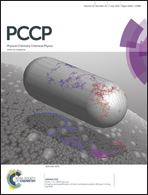Performance analysis of energy conversion via caloric effects in first-order ferroic phase transformations
Abstract
A finite-time thermodynamic model of ferroic refrigerators and generators, based on first order phase transformation, is given. We use this model to evaluate a novel method of converting heat directly into electricity based on the martensitic phase transformation accompanied by an abrupt change in magnetic ordering recently discovered [Srivastava et al., Adv. Energy Mater., 2011, 1, 97]. In this paper, we study the efficiency and power output of this method. The formulas of efficiency and power output in terms of material constants, design parameters, and working conditions are derived. The Clausius–Clapeyron coefficient is shown to be important to the efficiency. The figure of merit, as a dimensionless parameter, of energy conversion using the new method is introduced. It is shown that, as the figure of merit goes to infinity, the efficiency approaches the Carnot efficiency. Thermodynamic cycles of the new energy conversion method are optimized for a maximum power output. The matching criteria between materials and working temperatures of such optimized cycles are derived. Using these criteria, one can choose the most suitable materials under given working conditions, or decide the best working conditions for available materials.


 Please wait while we load your content...
Please wait while we load your content...